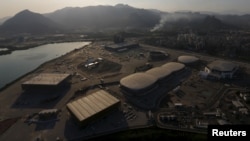When Rio opened its Olympic Park this month there was one thing conspicuously absent around the venues, walkways and public areas where visitors will gather to watch 16 sports in August: trees.
The host city and AECOM, the U.K.-based company that designed what is being dubbed "the heart of the games," promised a verdant area worthy of the name Park. The reality is a concrete jungle.
The reason? People.
"The option to reduce the number of trees compared to the original project is justified by the need to offer more open spaces so spectators can circulate," the municipal body in charge of infrastructure for the games said in an emailed response to questions.
The grey scenario would be grim anywhere but is all the more arresting in a city built on the edge of the Atlantic Forest and surrounded by ocean, lagoons and thick woods.
The Brazilian project manager said that even though the park was opened by Rio Mayor Eduardo Paes on April 12, the work was not complete and more fauna would be added to complement the roughly 7,655 square yards (6,400 square meters) of synthetic grass.
"Maybe in our perspective there was a little bit more green," Nadja de Almeida, an AECOM operations manager, told Reuters.
"But there are still some trees coming. A lot are in nurseries and will come in only around July. You'll definitely see more."
The park cost 2.34 billion reais ($656 million) and was designed by 200 architects, 20 of them Brazilian. The International Olympic Committee and Rio 2016 had the final say on its design.
Home to nine venues and 16 disciplines, more than any other venue cluster, the park will be a focal point of the games with tens of thousands of people expected to visit each day.
The area will be transformed after the games. One of the arenas will be dismantled and turned into four schools. Most of the others will be used as training centers for athletes.
Parts of the park will be turned over to developers.








